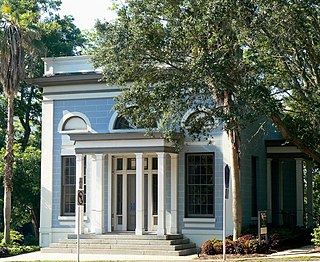
Tallahassee is the capital city of the U.S. state of Florida. It is the county seat and only incorporated municipality in Leon County. Tallahassee became the capital of Florida, then the Florida Territory, in 1824. In 2020, the population was 196,169, making it the 8th-largest city in the U.S state of Florida, and the 126th-largest city in the United States. The population of the Tallahassee metropolitan area was 385,145 as of 2018. Tallahassee is the largest city in the Florida Big Bend and Florida Panhandle region, and the main center for trade and agriculture in the Florida Big Bend and Southwest Georgia regions.

Florida Agricultural and Mechanical University (FAMU) is a public historically black land-grant university in Tallahassee, Florida. Founded in 1887, It is the third largest historically black university in the United States by enrollment and the only public historically black university in Florida. It is a member institution of the State University System of Florida, as well as one of the state's land grant universities, and is accredited to award baccalaureate, master's and doctoral degrees by the Commission on Colleges of the Southern Association of Colleges and Schools.

HCA Healthcare is an American for-profit operator of health care facilities that was founded in 1968. It is based in Nashville, Tennessee, and, as of May 2020, owns and operates 186 hospitals and approximately 2,000 sites of care, including surgery centers, freestanding emergency rooms, urgent care centers and physician clinics in 21 states and the United Kingdom. As of 2021, HCA Healthcare is ranked #62 on the Fortune 500 rankings of the largest United States corporations by total revenue.

Tenet Healthcare Corporation is a multinational healthcare services company based in Dallas, Texas, United States. Through its brands, subsidiaries, joint ventures, and partnerships, including United Surgical Partners International (USPI), the company operates 65 hospitals and over 450 healthcare facilities. Tenet also operates Conifer Health Solutions, which provides healthcare support services to health systems and other clients.
Home health nursing is a nursing specialty in which nurses provide multidimensional home care to patients of all ages. Home health care is a cost efficient way to deliver quality care in the convenience of the client's home. Home health nurses create care plans to achieve goals based on the client's diagnosis. These plans can include preventive, therapeutic, and rehabilitative actions. Home health nurses also supervise certified nursing assistants. The professional nursing organization for home health nurses is the Home Healthcare Nurses Association (HHNA). Home health care is intended for clients that are well enough to be discharged home, but still require skilled nursing personnel to assess, initiate and oversee nursing interventions.

Alonzo Smith "Jake" Gaither was an American football coach and college athletics administrator. He served as the head football coach at Florida A&M University (FAMU) for 25 years, from 1945 to 1969, compiling a record of 204–36–4. His won–loss record is among the best of any college football coach.
The history of Tallahassee, Florida, much like the history of Leon County, dates back to the settlement of the Americas. Beginning in the 16th century, the region was colonized by Europeans, becoming part of Spanish Florida. In 1819, the Adams–Onís Treaty ceded Spanish Florida, including modern-day Tallahassee, to the United States. Tallahassee became a city and the state capital of Florida in 1821; the American takeover led to the settlements' rapid expansion as growing numbers of cotton plantations began to spring up nearby, increasing Tallahassees' population significantly.

The Union Bank of Tallahassee, Florida was established around 1830 and the bank building constructed for it in 1841. It is Florida's oldest surviving bank building. It is located at Apalachee Parkway and Calhoun Street and is now a museum and archive and research center for African American history. On February 24, 1971, it was added to the U.S. National Register of Historic Places.

Tallahassee Memorial HealthCare (TMH) is a private, not-for-profit community healthcare system founded in 1948. Located in Tallahassee, Florida, United States and serving a 16-county region in North Florida and South Georgia, TMH comprises a 772-bed acute care hospital, a psychiatric hospital, multiple specialty care centers, three residency programs, 22 affiliated physician practices, and partnerships with Doctors’ Memorial Hospital, UF Health, and Weems Memorial Hospital.

The Florida State University College of Medicine, located in Tallahassee, Florida, is one of sixteen colleges composing the Florida State University. The college, created in 2000, is an accredited medical school, offering the Doctor of Medicine (M.D.) degree for physicians. The College of Medicine also offers a Ph.D. degree and a Physician Assistant program.
In the United States, Medicare fraud is the claiming of Medicare health care reimbursement to which the claimant is not entitled. There are many different types of Medicare fraud, all of which have the same goal: to collect money from the Medicare program illegitimately.
The Florida State University College of Nursing, is the nursing school of the Florida State University. About 553 students are enrolled in classes, including undergraduates and graduate students. All programs are accredited by the Commission on Collegiate Nursing Education.

Wolfson Children's Hospital is a nationally ranked, non-profit, pediatric acute care hospital located in Jacksonville, Florida. It has 216 beds and is the primary pediatric teaching affiliate of the University of Florida College of Medicine-Jacksonville and the Florida branch of the Mayo Clinic Alix School of Medicine. The hospital is a part of the Baptist Health system, and the only children's hospital in the system. It provides comprehensive pediatric specialties and subspecialties to pediatric patients aged 0–21 throughout Jacksonville and the Northern Florida region, but also treats some adults that would be better treated under pediatric care. Wolfson Children's Hospital also features the only state verified level 1 pediatric trauma center in the region, and one of five in the state. A new inpatient building under construction as of 2020 will increase the hospital's number of beds to 298.

Kaleida Health, founded in 1998, is a not-for-profit healthcare network that manages five hospitals in the Buffalo-Niagara Falls metropolitan area. Prior to the merger of member hospitals into the network, it was known as the Millard Fillmore Health System.
Hospice care is a type of health care that focuses on the palliation of a terminally ill patient's pain and symptoms and attending to their emotional and spiritual needs at the end of life. Hospice care prioritizes comfort and quality of life by reducing pain and suffering. Hospice care provides an alternative to therapies focused on life-prolonging measures that may be arduous, likely to cause more symptoms, or are not aligned with a person's goals.

Guam Memorial Hospital is located in Tamuning, Guam and is the public civilian hospital serving the island of Guam. The hospital has 158 licensed acute care beds, plus 40 beds at its off-site, long-term care Skilled Nursing Facility.
As of 2017, approximately 1.4 million Americans live in a nursing home, two-thirds of whom rely on Medicaid to pay for their care. Residential nursing facilities receive Medicaid federal funding and approvals through a state health department. These facilities may be overseen by various types of state agency.
Nelson Elijah Townsend was an American college athletics administrator. Townsend served seven tenures as athletic director at four different universities: the University of Maryland Eastern Shore, Delaware State University (1979–1986), Florida A&M University and the University at Buffalo (1987–1998). He was the University at Buffalo's first African American athletic director. At both Delaware State and Buffalo, Townsend was responsible for leading the athletic department to achieve full NCAA Division I status, as both schools transitioned from lower levels of NCAA hierarchy. Townsend was inducted to the Mid-Eastern Athletic Conference Hall of Fame in 1995 and was inducted to both the University of Maryland Eastern Shore and National Association of Collegiate Directors of Athletics Halls of Fame in 2012.
The 1968 Tallahassee riots were one of many riots that broke out after Martin Luther King was assassinated in Tallahassee, Florida lasting from April 5–7, 1968. It was originally a student protest but later became a riot as a result of the rage and anger of participants. The riot would happened at Florida A & M University but unrest would be seen to a lesser extent in the Frenchtown neighborhood.












